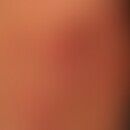DefinitionThis section has been translated automatically.
SERPINB8 (SERPINB8 stands for Serpin Family B Member 8) is a protein coding gene located on chromosome 18q22.1. The protein encoded by this gene belongs to the serine protease inhibitor family.
The encoded protein is produced by platelets and can bind to and inhibit the function of furin, a serine protease involved in platelet functions. In addition, this protein has been found to improve the mechanical stability of cell-cell adhesion in the skin. Defects in SERPINB8 have been associated with an autosomal recessive form of exfoliative ichthyosis (see peeling skin syndrome below).
ClinicThis section has been translated automatically.
Diseases associated with SERPINB8 include.
Pigors M et al (2016) reported three unrelated families with loss-of-function mutations in SERPINB8 associated with an autosomal recessive form of exfoliative ichthyosis(peeling skin syndrome 5). Whole-exome sequencing of affected individuals from a consanguineous Tunisian family and a large Israeli family revealed a homozygous frameshift mutation, c.947delA (p.Lys316Serfs(∗)90), and a nonsense mutation, c.850C>T (p.Arg284(∗)), respectively. These two mutations are located in the last exon of SERPINB8. Apparently, both mutations lead to the loss of the loop of the reactive site of SERPINB8, which is crucial for the formation of the SERPINB8 protease complex.
Histological analysis of a skin biopsy from a homozygous individual for the p.Arg284(∗) variant showed loss of keratinocyte adhesion in the lower epidermal layers and decreased SERPINB8 levels compared with controls. (Cell-to-cell adhesion). SERPINB8 contributes to the mechanical stability of intercellular adhesions in the epidermis.
LiteratureThis section has been translated automatically.
- Ahmad F et al. (2018) A disease-causing novel missense mutation in the ST14 gene underlies autosomal recessive ichthyosis with hypotrichosis syndrome in a consanguineous family. Eur J Dermatol 28:209-216.
- Blaydon DC et al (2011) Mutations in CSTA, encoding cystatin A, underlie exfoliative ichthyosis and reveal a role for this protease inhibitor in cell-cell adhesion. Am J Hum Genet 89:564-571.
- Pigors M et al (2016) Loss-of-function mutations in SERPINB8 Linked to Exfoliative Ichthyosis with Impaired Mechanical Stability of Intercellular Adhesions. Am J Hum Genet 99:430-436.




